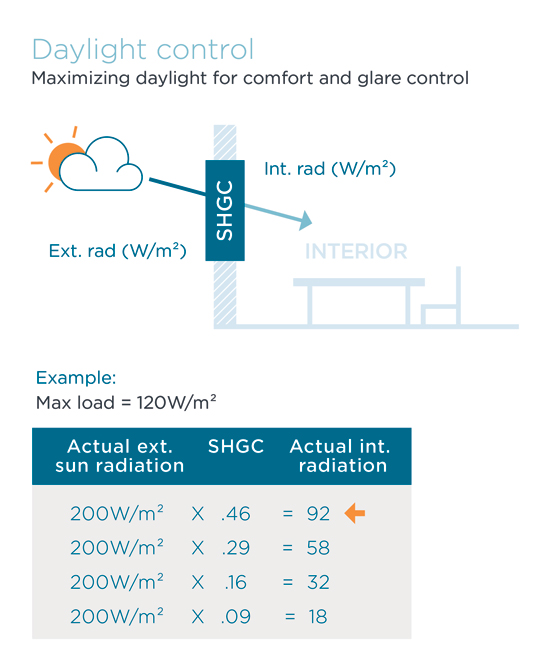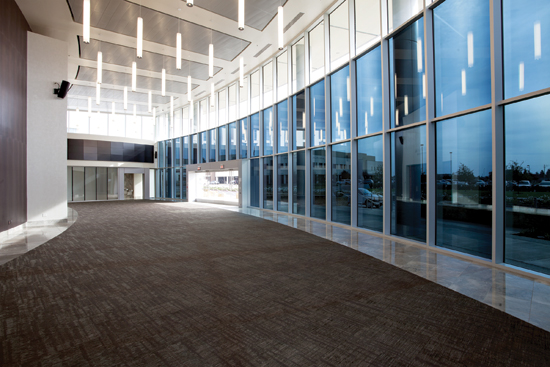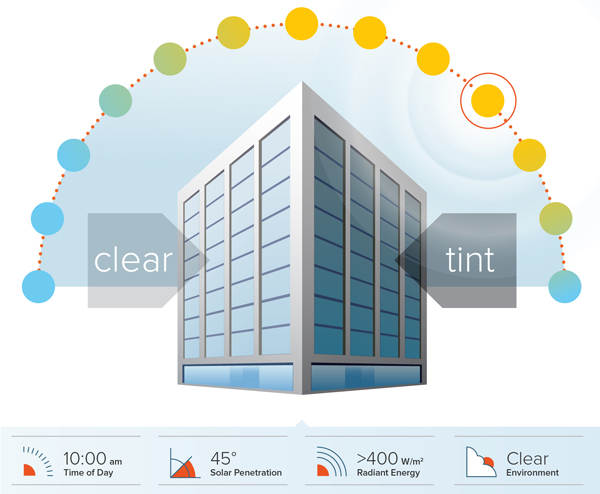The Move to Dynamic Glass
Daylight control. Based on actual environmental conditions, the intelligence function adjusts the tint level to achieve maximum amount of daylight. The inside radiation equals the outside radiation * SHGC of glass. Based on actual environmental conditions, the tint level will be adjusted to achieve the maximum amount of daylight.
 |
|
Image courtesy of View Inc. |
System Architecture
A focus on simplification and performance has driven a major rethinking of the dynamic glass electronic system architecture. In many cases, traditional complex wiring approaches have been replaced by a single line or cable, similar to a LAN network, to facilitate routing and reduce install complexity. Factory pre-terminated wiring with threaded connectors cuts labor time and adds to long-term reliability. Window control has been moved to intelligent nodes close to the window to optimize tint uniformity and allow maximum zone control flexibility, user control, and ease of future reconfiguration. Intelligence at each point, from the insulated glass unit (IGU) back to the user interface, facilitates maximum user flexibility and central or individual control.
 |
Architects can specify large glass units active edge-to-edge without internal conductors that interrupt the view. Photo courtesy of View Inc. |
Energy Benefits
Dynamic glass contributes to thermal management of a building in two major ways:
Peak cooling load reduction. Dynamic glass can tint during peak cooling demand periods, thereby blocking more than 90 percent of solar radiation and resulting in a reduction of peak cooling required. This results in reduced HVAC equipment sizing as well as system simplicity when compared to traditional glazing solutions.
Annual energy savings. Due to its interactive nature, dynamic glass reduces overall HVAC energy consumption and costs by limiting unwanted heat gain in summer but allowing beneficial passive heat gain in winter. Intermediate states convey additional benefits by saving lighting energy, thus allowing for optimal daylighting.
These statements are based on whole-building energy simulations developed to compare the energy use of current low-E glazing and high-performance dynamic glass. A typical 20-story high-rise office building with high performance low-E glass was modeled against a building with dynamic glass. The analysis was conducted across five U.S. cities in different ASHRAE climate zones. The window-to-wall ratio modeled was 50 percent, which is typical for high-rise buildings. With all other aspects held constant, the difference in energy performance was a direct result of the performance of the glass. Averaged across these typical climates, use of dynamic glass reduces lighting and HVAC electricity (space cooling, ventilation fans, pumps) consumption by 20 percent. The savings in lighting energy is attributed to the intermediate state features of dynamic glass and dimmable lighting.
Compared to high-performance low-E glazing, the dynamic glass modeled reduced the building's cooling peak load by 23 percent which in turn results in a reduction of HVAC system size (reduced cooling tons, fan, shaft and duct size, chiller, terminal units, diffusers, pumps, and water circulation) required to meet the peak load in the building. Beyond the opportunity of straightforward equipment cost reductions, the reduced peak cooling loads also offer a chance to use alternate cooling systems. Options such as radiant chilled ceilings and displacement ventilation can further reduce capital costs, lower maintenance or add greater design flexibility. Peak load reduction can decrease and possibly eliminate peak demand utility charges as well. Reducing peak loads for the building allows for the negotiation of a lower peak demand structure and passes significant operating cost savings to the owners of such facilities.
In a similar analysis, a typical 4-story low-rise, 40 percent window-to-wall ratio office building with high-performance low-E glass was modeled against a building with dynamic glass. The low-E glass building contained a shading overhang on the southern façade, which was eliminated for the dynamic glass building. Otherwise, the two buildings were identical. On average, use of dynamic glass was found to reduce lighting and HVAC electricity (space cooling, ventilation fans, pumps) consumption by 14 percent, and cooling peak load by 8 percent. Even in smaller buildings with less fenestration, dynamic glass has substantial energy and design benefits.
 |
|
Image courtesy of View Inc. |









